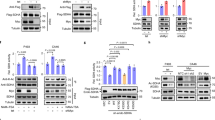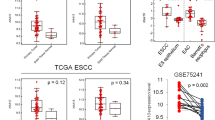Abstract
The N-α-acetyltransferase NatB, composed in Saccharomyces cerevisiae by the Nat3p and Mdm20p subunits, is an important factor for yeast growth and resistance to several stress agents. However, the expression and functional role of the mammalian counterpart has not yet been analysed. Here, we report the identification of Nat3p human homologue (hNAT5/hNAT3) and the characterization of its biological function. We found that hNAT5/hNAT3 silencing in HeLa cells results in inhibition of cell proliferation and increased sensitivity to the pro-apoptotic agent MG132. Moreover, inhibition of hNAT5/hNAT3 expression induces p53 activation and upregulation of the antiproliferative protein p21(WAF1/CIP1). The changes of the cellular transcriptome after hNAT5/hNAT3 knockdown confirmed the involvement of this protein in cell growth and survival processes. Among the genes differentially expressed, we observed upregulation of several p53-dependent antiproliferative and pro-apoptotic genes. In the c-myc transgenic mice, which is a model of inducible hepatocarcinoma, we found that hNAT5/hNAT3 was upregulated when the tumour was induced. In accordance with this observation, we noticed increased hNAT5/hNAT3 protein level in neoplastic versus non-neoplastic tissue in a high proportion of patients with hepatocellular carcinoma. Consequently, our results suggest that hNAT5/hNAT3 is required for cellular proliferation and can be implicated in tumour growth.
This is a preview of subscription content, access via your institution
Access options
Subscribe to this journal
Receive 50 print issues and online access
$259.00 per year
only $5.18 per issue
Buy this article
- Purchase on Springer Link
- Instant access to full article PDF
Prices may be subject to local taxes which are calculated during checkout






Similar content being viewed by others
References
Agarwal MK, Hastak K, Jackson MW, Breit SN, Stark GR, Agarwal ML . (2006). Macrophage inhibitory cytokine 1 mediates a p53-dependent protective arrest in S phase in response to starvation for DNA precursors. Proc Natl Acad Sci USA 103: 16278–16283.
Arnesen T, Anderson D, Baldersheim C, Lanotte M, Varhaug JE, Lillehaug JR . (2005a). Identification and characterization of the human ARD1-NATH protein acetyltransferase complex. Biochem J 386: 433–443.
Arnesen T, Gromyko D, Horvli O, Fluge O, Lillehaug J, Varhaug JE . (2005b). Expression of N-acetyl transferase human and human arrest defective 1 proteins in thyroid neoplasms. Thyroid 15: 1131–1136.
Arnesen T, Anderson D, Torsvik J, Halseth HB, Varhaug JE, Lillehaug JR . (2006a). Cloning and characterization of hNAT5/hSAN: an evolutionarily conserved component of the NatA protein N-alpha-acetyltransferase complex. Gene 371: 291–295.
Arnesen T, Gromyko D, Pendino F, Ryningen A, Varhaug JE, Lillehaug JR . (2006b). Induction of apoptosis in human cells by RNAi-mediated knockdown of hARD1 and NATH, components of the protein N-alpha-acetyltransferase complex. Oncogene 25: 4350–4360.
Borras-Cuesta F, Golvano J, Sarobe P, Lasarte J.J, Prieto I, Szabo A . (1991). Insights on the amino acid side-chain interactions of a synthetic T-cell determinant. Biologicals 19: 187–190.
Bode AM, Dong Z . (2004). Post-translational modification of p53 in tumorigenesis. Nat Rev Cancer 4: 793–805.
Braun K, Holzl G, Soucek T, Geisen C, Moroy T, Hengstschlager M . (1998). Investigation of the cell cycle regulation of cdk3-associated kinase activity and the role of cdk3 in proliferation and transformation. Oncogene 17: 2259–2269.
Brummelkamp TR, Bernards R, Agami R . (2002). A system for stable expression of short interfering RNAs in mammalian cells. Science 296: 550–553.
Caesar R, Warringer J, Blomberg A . (2006). Physiological importance and identification of novel targets for the N-terminal acetyltransferase NatB. Eukaryot Cell 5: 368–378.
Cartier N, Miquerol L, Tulliez M, Lepetit N, Levrat F, Grimber G et al. (1992). Diet-dependent carcinogenesis of pancreatic islets and liver in transgenic mice expressing oncogenes under the control of the L-type pyruvate kinase gene promoter. Oncogene 7: 1413–1422.
Cartier N, Briand P, Kahn A . (1994). Creation of diet-dependent cancer models in transgenic animals. Bull Acad Natl Med 178: 23–32; discussion 32–4.
Cheung PK, Woolcock B, Adomat H, Sutcliffe M, Bainbridge TC, Jones EC et al. (2004). Protein profiling of microdissected prostate tissue links growth differentiation factor 15 to prostate carcinogenesis. Cancer Res 64: 5929–5933.
Dutnall RN, Tafrov ST, Strenglanz R, Ramakrishnan V . (1998). Structure of the histone acetyltransferase Hat1: a paradigm for the GCN5-related N-acetyltransferase family. Cell 94: 427–438.
Fisher TS, Etages SD, Hayes L, Crimin K, Li B . (2005). Analysis of ARD1 function in hypoxia response using retroviral RNA interference. J Biol Chem 280: 17749–17757.
Fluge O, Bruland O, Akslen LA, Varhaug JE, Lillehaug JR . (2002). NATH, a novel gene overexpressed in papillary thyroid carcinomas. Oncogene 21: 5056–5068.
Gautschi M, Just S, Mun A, Ross S, Rucknagel P, Dubaquie Y et al. (2003). The yeast N(alpha)-acetyltransferase NatA is quantitatively anchored to the ribosome and interacts with nascent polypeptides. Mol Cell Biol 23: 7403–7414.
Gendron RL, Adams LC, Paradis H . (2000). Tubedown-1, a novel acetyltransferase associated with blood vessel development. Dev Dyn 218: 300–315.
Hardy S, Kitamura M, Harris-Stansil T, Dai Y, Phipps ML . (1997). Construction of adenovirus vectors through Cre-lox recombination. J Virol 71: 1842–1849.
Joo HY, Zhai L, Yang C, Nie S, Erdjument-Bromage H, Tempst P et al. (2007). Regulation of cell cycle progression and gene expression by H2A deubiquitination. Nature 449: 1068–1072.
Kannan K, Amariglio N, Rechavi G, Jakob-Hirsch J, Kela I, Kaminski N et al. (2001). DNA microarrays identification of primary and secondary target genes regulated by p53. Oncogene 20: 2225–2234.
Kho PS, Wang Z, Zhuang L, Li Y, Chew JL, Ng HH et al. (2004). p53-regulated transcriptional program associated with genotoxic stress-induced apoptosis. J Biol Chem 279: 21183–21192.
Lavin MF, Gueven N . (2006). The complexity of p53 stabilization and activation. Cell Death Differ 13: 941–950.
Lim JH, Park JW, Chung YS . (2006). Human arrest defective 1 acetylates and activates beta-catenin, promoting lung cancer cell proliferation. Cancer Res 66: 10677–10682.
Lim JH, Park JW, Min DS, Chang JS, Lee YH, Park YB et al. (2007). NAG-1 up-regulation mediated by EGR-1 and p53 is critical for quercetin-induced apoptosis in HCT116 colon carcinoma cells. Apoptosis 12: 411–421.
Line A, Stengrevics A, Slucka Z, Li G, Jankevics E, Rees RC . (2002). Serological identification and expression analysis of gastric cancer-associated genes. Br J Cancer 86: 1824–1830.
Liu G, Chen X . (2002). The ferredoxin reductase gene is regulated by the p53 family and sensitizes cells to oxidative stress-induced apoptosis. Oncogene 21: 7195–7204.
Liu G, Lozano G . (2005). p21 stability: linking chaperones to a cell cycle checkpoint. Cancer Cell 7: 113–114.
Neuwald AF, Landsman D . (1997). GCN5-related histone N-acetyltransferases belong to the diverse superfamily that includes the yeast SPT10 protein. Trends Biochem Sci 22: 154–155.
Polevoda B, Norbeck J, Takakura H, Blomberg A, Sherman F . (1999). Identification and specificities of N-terminal acetyltransferases from Saccharomyces cerevisiae. Embo J 18: 6155–6168.
Polevoda B, Sherman F . (2003). N-terminal acetyltransferases and sequence requirements for N-terminal acetylation of eukaryotic proteins. J Mol Biol 325: 595–622.
Polevoda B, Cardillo TS, Doyle TC, Bedi GC, Sherman F . (2003). Nat3p and Mdm20p are required for function of yeast NatB Nalpha-terminal acetyltransferase and of actin and tropomyosin. J Biol Chem 278: 30686–30697.
Polevoda B, Brown S, Cardillo TS, Rigby S, Sherman F . (2008). Yeast N(alpha)-terminal acetyltransferases are associated with ribosomes. J Cell Biochem 103: 492–508.
Rellos P, Ivins FJ, Baxter JE, Pike A, Nott TJ, Parkinson DM et al. (2007). Structure and regulation of the human Nek2 centrosomal kinase. J Biol Chem 282: 6833–6842.
Reynolds A, Leake D, Boese Q, Scaringe S, Marshall WS, Khvorova A . (2004). Rational siRNA design for RNA interference. Nat Biotechnol 22: 326–330.
Sim E, Walters K, Boukouvala S . (2008). Arylamine N-acetyltransferases: from structure to function. Drug Metab Rev 40: 479–510.
Simon HU, Mills GB, Kozlowski M, Hogg D, Branch D, Ishimi Y et al. (1994). Molecular characterization of hNRP, a cDNA encoding a human nucleosome-assembly-protein-I-related gene product involved in the induction of cell proliferation. Biochem J 297 (Part 2): 389–397.
Starheim KK, Arnesen T, Gromyko D, Ryningen A, Varhaug JE, Lillehaug J . (2008). Identification of the human Nalpha-acetyltransferase complex B (hNatB) - a complex important for cell cycle progression. Biochem J [e-pub ahead of print].
Singer JM, Shaw JM . (2003). Mdm20 protein functions with Nat3 protein to acetylate Tpm1 protein and regulate tropomyosin-actin interactions in budding yeast. Proc Natl Acad Sci USA 100: 7644–7649.
Spurgers KB, Gold DL, Coombes KR, Bohnenstiehl NL, Mullins B, Meyn RE et al. (2006). Identification of cell cycle regulatory genes as principal targets of p53-mediated transcriptional repression. J Biol Chem 281: 25134–25142.
Sugiura N, Patel RG, Corriveau RA . (2001). N-methyl-D-aspartate receptors regulate a group of transiently expressed genes in the developing brain. J Biol Chem 276: 14257–14263.
Sugiura N, Adams SM, Corriveau RA . (2003). An evolutionarily conserved N-terminal acetyltransferase complex associated with neuronal development. J Biol Chem 278: 40113–40120.
Vousden KH . (2000). p53: death star. Cell 103: 691–694.
Wise-Draper TM, Allen HV, Jones EE, Habash KB, Matsuo H, Wells SI . (2006). Apoptosis inhibition by the human DEK oncoprotein involves interference with p53 functions. Mol Cell Biol 26: 7506–7519.
Xie S, Wu H, Wang Q, Cogswell JP, Husain I, Conn C et al. (2001). Plk3 functionally links DNA damage to cell cycle arrest and apoptosis at least in part via the p53 pathway. J Biol Chem 276: 43305–43312.
Yu J, Zhang L, Hwang PM, Rago C, Kinzler KW, Vogelstein B . (1999). Identification and classification of p53-regulated genes. Proc Natl Acad Sci USA 96: 14517–14522.
Acknowledgements
We thank Dr Christine Perret for the transgenic mice, Dr Carmen Berasain and Dr Maider Zabala for providing samples, Dr Francisco Borrás-Cuesta and Virginia Belsué for peptides synthesis, Dr Victor Segura for bioinformatics assistance and Sandra Jusue, Maite Corres and Beatriz Carte for excellent technical assistance. AA was supported by an FPU training fellowship (AP2001-1567) and RA was supported by an FIS research contract. CIBEREHD is funded by Instituto de Salud Carlos III, and this research was partially supported by grants from Ministerio de Sanidad y Consumo (02/3054), Departamento de Educación, Gobierno de Navarra (GNE-Enzima N) and UTE project CIMA.
Author information
Authors and Affiliations
Corresponding author
Rights and permissions
About this article
Cite this article
Ametzazurra, A., Larrea, E., Civeira, M. et al. Implication of human N-α-acetyltransferase 5 in cellular proliferation and carcinogenesis. Oncogene 27, 7296–7306 (2008). https://doi.org/10.1038/onc.2008.332
Received:
Revised:
Accepted:
Published:
Issue Date:
DOI: https://doi.org/10.1038/onc.2008.332
Keywords
This article is cited by
-
Structural basis of Naa20 activity towards a canonical NatB substrate
Communications Biology (2021)
-
Naa20, the catalytic subunit of NatB complex, contributes to hepatocellular carcinoma by regulating the LKB1–AMPK–mTOR axis
Experimental & Molecular Medicine (2020)
-
Spotlight on protein N-terminal acetylation
Experimental & Molecular Medicine (2018)
-
Naa50/San-dependent N-terminal acetylation of Scc1 is potentially important for sister chromatid cohesion
Scientific Reports (2016)
-
Absence of N-terminal acetyltransferase diversification during evolution of eukaryotic organisms
Scientific Reports (2016)



